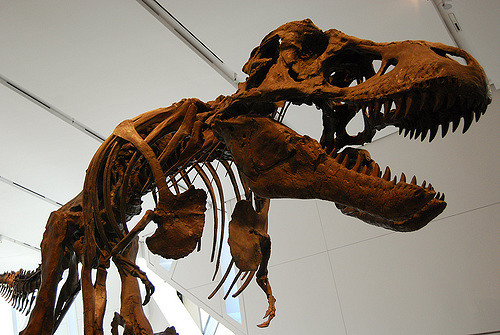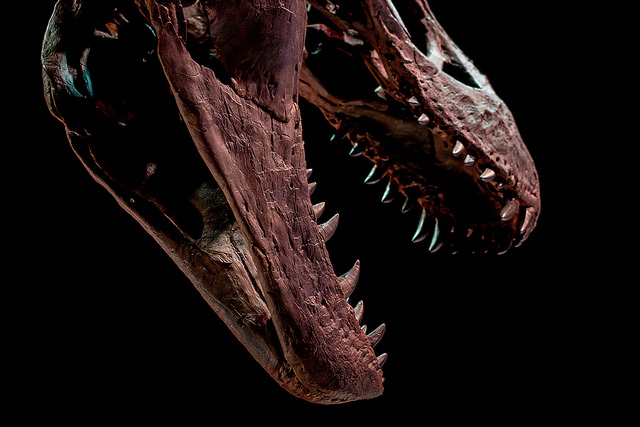
Scientists have discovered what appears to be preserved red blood cells and soft tissue in the fossilized remains of dinosaurs that roamed the Earth 75 million years ago.
While the discovery is highly unlikely to lead to a real-life scenario of the 1993 film Jurassic park, it is believed the discovery help us answer some long-standing questions about dinosaur physiology.
For example, if we are able to collect blood cell or soft tissue samples from a number of species from the Mesozoic Era, we may finally be able to determine which specific species were warm-blooded and cold-blooded.
The work, published in the journal Nature Communications, explains how researchers as the Imperial College London “discovered 2 tiny ovoid structures with an inner denser core that resembled red blood cells” when examining part of a fossilized dinosaur claw.
In addition to this discovery, fibrous features with a banded structure similar to that seen in modern-day collagen was found in another fossil fragment. However, this is not the first time scientists have made such a discovery.
Mary Schweitzer, a paleontologist at North Carolina State University, discovered the remains of blood cells in dinosaur fossils back in 2005 – the first of its kind. Just a year later, Schweitzer successfully discovered and extracted soft tissue from the pristine remains of a 68-million-year-old T. rex.

“All of the previous reports of original components of soft tissues in dinosaur fossils have tended to be in specimens that are really exceptionally preserved – one-offs, really, that require special pleading to explain how they got preserved,” co-author Susannah Maidment told BBC News.
In comparison, the fossils examined by researchers of the Imperial College London had been poorly preserved and had been lying in the London Natural History Museum for more than a century.
“They’re very scrappy, individual broken bones. I can’t even tell you what dinosaur they come from,” said Dr Maidment.
Although this is not the first time soft tissue and blood cells have been found in dinosaur fossils, the discovery could help us determine why living cells are able to survive for such long periods of time – especially since it is textbook knowledge that after death our blood cells and living tissue decay.
“If you’re finding soft tissues in these kinds of fossils, maybe this kind of preservation might be more common than we realised, and might even be the norm,” Dr Maidment said.
Upon carrying out a chemical analysis of the putative collagen protein and the candidate blood cells, the researchers discovered fragments of amino acids typical of collagen fibers, reports the BBC.
In addition to studying the soft tissues in detail, scientists are also hoping to examine more fossils in the search for more blood cells and soft tissue. Once enough samples have been collected, the scientists believe they can determine to sorts of burial requirements for the survival of soft tissue in fossils.
Finally, if blood cells and soft tissue can be collected from many different dinosaur species, it is hoped that some of the long-standing mysteries of dinosaur evolution will finally be uncovered.
“If we could extract some of the collagen… and we could find it in lots of different dinosaurs, it could give us a sense of relatedness within the dinosaur family tree,” said Dr Maidment.
While the discovery of red blood cells and soft tissue in poorly preserved dinosaur fossils is an amazing discovery in itself, it also opens the door to questions regarding the preservation of dinosaur DNA. After all, if soft tissue can survive more than 75 million years, who are we to say that DNA cannot survive either.
“We haven’t found any genetic material in our fossils, but generally in science, it is unwise to say never,” said Maidment.
“This opens up the possibility of loads of specimens that may have soft tissue preserved in them, but the problem with DNA is that even if you find it, it won’t be intact. It’s possible you could find fragments, but to find more than that? Who knows?” adds Sergio Bertazzo, a materials scientist at Imperial.
Image: Flickr, Mike Shaver
You want to support Anonymous Independent & Investigative News? Please, follow us on Twitter: Follow @AnonymousNewsHQ
This article (Scientist Discover Red Blood Cells and Soft Tissue in 75-Million-Year-Old Dinosaur Fossils) is a free and open source. You have permission to republish this article under a Creative Commons license with attribution to the author and AnonHQ.com.





where they found it? probobly in the fridge alongsine a ufo